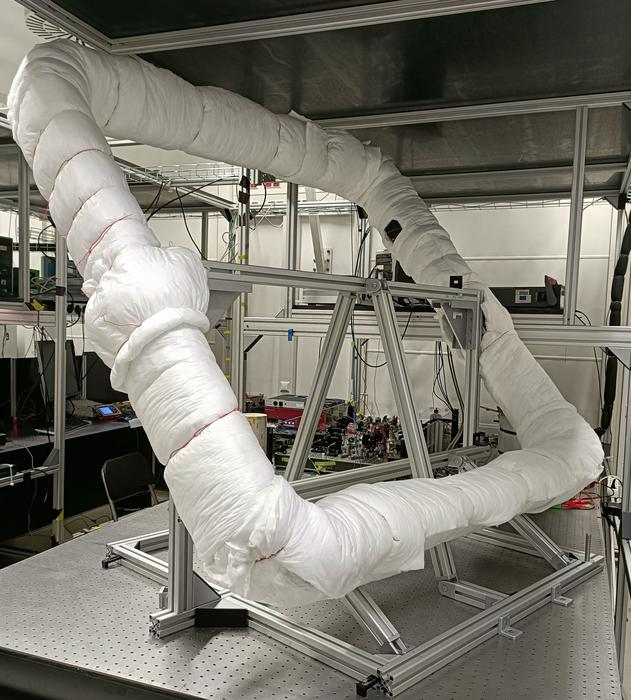First time ever: Quantum entanglement used to measure the Earth’s rotation
The sensitivity of entanglement-based sensors paves the way for future research that bridges quantum mechanics and general relativity.

A team of researchers led by Philip Walther at the University of Vienna conducted a groundbreaking experiment measuring the Earth's rotation effect on quantum entangled photons.
This study, published in Science Advances, marks a significant advancement in the field, enhancing the sensitivity of entanglement-based sensors and potentially paving the way for future research that bridges quantum mechanics and general relativity.
Optical Sagnac interferometers, known for their exceptional sensitivity to rotational movements, have been essential in the realm of fundamental physics since the early 20th century. They played a key role in solidifying Einstein's special theory of relativity and remain the gold standard for measuring rotational speeds, though they are limited by classical physics.
Quantum entanglement offers a potential breakthrough in overcoming these limitations. When particles are entangled, their overall state is known, but the state of each individual particle remains undetermined until measured. This phenomenon can yield more information per measurement than traditional methods. However, the fragility of entanglement has hindered its practical application in enhancing sensitivity—until now.
The Vienna team's experiment introduced a giant optical fiber Sagnac interferometer, maintaining low and stable noise levels for several hours. This setup allowed them to detect a high quantity of entangled photon pairs, achieving a rotational precision a thousand times greater than that of previous quantum optical Sagnac interferometers.
In a Sagnac interferometer, particles traveling in opposite directions along a rotating closed path return to the starting point at different times. With entangled particles, this effect is magnified, as they behave like a single entity testing both directions simultaneously, accumulating double the time delay.
Related Stories
This property, known as super-resolution, was crucial in their experiment. The researchers used a 2-kilometer-long optical fiber wound onto a large coil, creating an interferometer with an effective area exceeding 700 square meters.
One major challenge was isolating and extracting Earth's steady rotation signal. "The core of the matter," explains lead author Raffaele Silvestri, "lays in establishing a reference point for our measurement, where light remains unaffected by Earth's rotational effect. Given our inability to halt Earth's from spinning, we devised a workaround: splitting the optical fiber into two equal-length coils and connecting them via an optical switch."
By toggling the switch, they effectively canceled the rotation signal at will, enhancing the stability of their large apparatus. "We have basically tricked the light into thinking it's in a non-rotating universe," says Silvestri.
This experiment, part of the TURIS research network hosted by the University of Vienna and the Austrian Academy of Sciences, successfully demonstrated the Earth's rotational effect on a maximally entangled two-photon state. This confirms the interaction between rotating reference systems and quantum entanglement, as described in Einstein's special theory of relativity and quantum mechanics, with a thousand-fold precision improvement over previous experiments.
Haocun Yu, a Marie-Curie Postdoctoral Fellow involved in the experiment, highlighted its significance: "That represents a significant milestone since, a century after the first observation of Earth’s rotation with light, the entanglement of individual quanta of light has finally entered the same sensitivity regimes."
Philip Walther added, "I believe our result and methodology will set the ground to further improvements in the rotation sensitivity of entanglement-based sensors. This could open the way for future experiments testing the behavior of quantum entanglement through the curves of spacetime."
This pioneering research not only enhances our understanding of quantum mechanics but also has potential implications for future technologies. By integrating quantum entanglement with classical physics, scientists can develop more precise instruments for a variety of applications, from navigation systems to fundamental tests of the universe's underlying principles.
The success of this experiment showcases the immense possibilities that lie at the intersection of quantum mechanics and general relativity, setting a new standard for future scientific exploration.
Note: Materials provided above by The Brighter Side of News. Content may be edited for style and length.
Like these kind of feel good stories? Get the Brighter Side of News' newsletter.
Joseph Shavit
Head Science News Writer | Communicating Innovation & Discovery
Based in Los Angeles, Joseph Shavit is an accomplished science journalist, head science news writer and co-founder at The Brighter Side of News, where he translates cutting-edge discoveries into compelling stories for a broad audience. With a strong background spanning science, business, product management, media leadership, and entrepreneurship, Joseph brings a unique perspective to science communication. His expertise allows him to uncover the intersection of technological advancements and market potential, shedding light on how groundbreaking research evolves into transformative products and industries.



